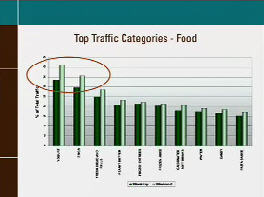It seems improbable that there was ever a time when skilled marketers didn’t use at least some traffic data to make improvements to their sites. The availability of this data, no matter how flawed, has been a chief impetus for the growth of web marketing as a discipline. The comparison was always with the dearth of similar data from bricks and mortar stores. Here are a few specifics:
-
Stage of Purchase Web Metric Store Metric Initiation Unique Visits Foot Traffic Counts Consideration Page Views None Available Completion Transactional Data Transactional Data
This list is over-simplified, but it makes a point. In the Consideration Stage — between the time when the door store swings open and the time the purchase is rung up — there is little to help the bricks and mortar marketer understand the motivation of the customer.
By comparison, a web marketer has a full toolkit of metrics. There are page views to show visits to specific product pages and web site sections, exit pages to show when a consumer decides to leave without buying, and shopping cart abandonment metrics to show exactly when a consumer decided to stop his or her purchase.
This stark difference is changing fast.
PRISM (short for “Pioneering Research for an In-Store Metric”), is a Nielsen Media / In-store Marketing Institute co-production. Working with a consortium of retailers and consumer-goods manufacturers, the duo completed a test recently using sensors placed at key points in over 160 stores around the country. These sensors monitored the entrances and exits, as well as some store aisles, composing data sets and even heat maps of customer-traffic patterns.
In a way that is uncannily similar to web analytics, the PRISM system combined these traffic data with transactional information. The end game is to achieve greater insight into consumer behavior.
 As you can imagine, the potential for improving the in-store experience is huge. Just as web marketers have walked away with significant improvements to their sites through web analytics, these marketers are nearly giddy with new-found knowledge. At least, that’s the impression I’ve received by press accounts of PRISM. This piece in In-Store Marketing Institute’s site is characteristic of that excitement, particularly in this accompanying Flash and Quicktime video. (Warning: The video is all talking heads. Sadly, demonstrations of the system at work are being held closely under wraps.)
As you can imagine, the potential for improving the in-store experience is huge. Just as web marketers have walked away with significant improvements to their sites through web analytics, these marketers are nearly giddy with new-found knowledge. At least, that’s the impression I’ve received by press accounts of PRISM. This piece in In-Store Marketing Institute’s site is characteristic of that excitement, particularly in this accompanying Flash and Quicktime video. (Warning: The video is all talking heads. Sadly, demonstrations of the system at work are being held closely under wraps.)
Here is a typical insight, disclosed in the video by David Calhoun, CEO of the Nielsen Company:
“In some food stores, the heaviest traffic flow is not through the carbonated beverage and snack aisles — which might be the conventional wisdom based on sales rates — but through the yogurt and eggs section of the store.”
The chart above shows this (but not very well — it was captured from the video and only Calhoun’s narrative can identify the categories), with the two circled categories being the Yogurt and the Eggs sections.
Since the advent of web analytics, physical world marketers have looked at us web marketers with envy. It appears their time to play next to us, in the sandbox of database marketing, is just around the corner.